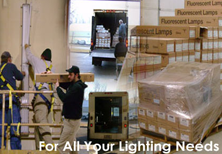Lighting Application Series: Intelligent Senior Housing Lighting
Of all the industries discussed in our Lighting Application Series, none need lighting optimization more than eldercare facilities, including assisted living, independent living, and skilled nursing care. This is because seniors have unique lighting needs and can experience major health, and mood benefits by having illumination designed especially for their eyes and by using sleep study lighting practices. By strategically using quality lights, like LEDs, those in this industry can serve their residents well while also being more energy efficient.

Considerations for Senior Lighting
As we get older, proper lighting becomes increasingly important in supporting our visual systems and overall health. Aging eyes, even those that are healthy, usually become more sensitive to glare, which means bulbs need to offer both higher contrast and illumination levels to prevent eye strain or fatigue. With proper lighting, seniors can experience:
- Natural circadian rhythms
- Better moods
- Improved visual acuity
- Heightened productivity
- Superior sleep
- Greater overall comfort and enjoyment
In addition, proper lighting makes the environment safer for older folks, since they can more easily see where they are going and avoid obstacles. Those who are in the senior housing industry should provide their residents with these benefits by retrofitting and optimizing their current lighting. This will lead to better satisfaction among the seniors and ultimately make the business more successful.
Smart Senior Housing Lighting
As mentioned, seniors respond best to lighting that has high contrast and illumination. Here are some suggestions on how you can make that happen and what other characteristics create quality lighting for older people:
Keep Ambient Lighting Uniform — Because older eyes take longer to adjust to changing light levels, it helps to keep ambient light the same from room to room.
Use Brighter Light — As the eye ages it’s not able to absorb as much light. Having brighter lights compensates for some of this. Seniors need 75% more light than the average 25-year-old.
Make it Glare-Free — Light scatters more in older eyes, making them more sensitive to glare. This, in turn, makes it harder to see details. You can reduce glares by using bright bulbs that are covered with some type of diffusing lenses.
Use Lights that Accentuate Color — The lens of the eye tends to yellow with age, which means many seniors have difficulty distinguishing colors.
You can lessen this effect by using bulbs with a color rendering index (CRI) of 80 or more. Also, a color temperature of around 3500K or higher is preferable for seniors. According to sleep study lighting research, seniors who are exposed to bluer light (the higher end of the color temperature scale) experience better sleep, since it more closely mimics daylight and promotes a natural circadian rhythm.
Eliminate Lights that Flicker or Hum – Older fluorescents are notorious for flickering and humming, which is not only annoying but can lead to headaches, eye strain, and general malaise.
Use Accent, Task, or Recessed Lights in Dim Areas — Stairs, hallways, kitchen counters, and similar areas are often dimmer than the main rooms. You can help residents see what they’re doing and have adequate depth perception by installing extra fixtures in these areas. Consider mounting lights in less visible places (under stair treads, below cabinets, etc.), so they provide the needed light but don’t add glare.
Add Motion Sensors — Motion sensors are energy efficient and they ensure residents never have to fumble for a light switch when entering a room or getting out of bed.
Efficient Senior Housing Lighting
Luckily, you can make all the changes mentioned above and still have a lighting system that’s more efficient and money-saving — a win-win for everyone. You can achieve this by installing LED bulbs and fixtures (or retrofitting your current setup to accommodate them). LEDs have one of the highest CRIs (some rated 90+) and a full range of color temperatures, which can provide the color enhancing light that seniors need. Recent advancements in LED technology have made them an intelligent choice for ambient lighting, and you can even put them in fixtures containing diffusers, louvers, lenses, shades, or reflectors, which allows them to emit soft, non-harsh illumination.
In terms of efficiency, LEDs are up to 10 times more efficient than CFLs and many more times efficient than incandescents. Also, some LEDs can last 70,000 hours or more before needing replacement (even when used 24 hours per day). This can add up to major savings in electric and maintenance costs and lead to relatively quick ROIs.
Final Considerations
Besides providing first rate illumination based on sleep study lighting research, perhaps the most important factor for providing intelligent senior housing lighting is integrating flexibility into the lighting options and controls. Not every older person requires precisely the same type of illumination, so giving them the ability to adjust things according to their needs leads to greater satisfaction for everyone. By giving them access to things like room dimmers, window shades, and lamps, they can create their own ideal lighting environments. This can also reduce energy costs, since not everyone will use full illumination all the time.
With over 65 million Baby Boomers expected to retire over the next couple decades, the demand for senior housing is only going up. Those in this industry can prepare for this aging population by adopting quality light that promotes health and well-being for seniors, and they can save money along the way by relying on smart technology, like LEDs.



No comments yet.